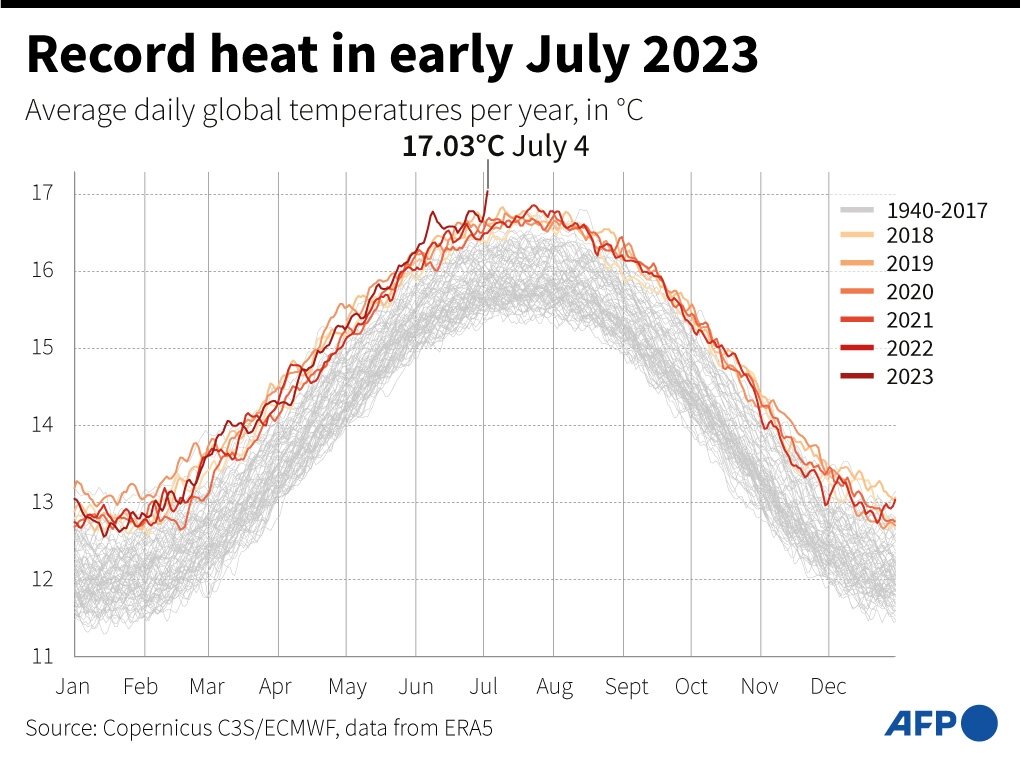
World daily temperature records have been shattered this week, based on early data, signaling a concerning trend in extreme heat. These estimates, though not as precise as official reports, offer valuable insights into potential climate impacts.
According to experts, the data behind these estimates is generated by modeling tools, with the University of Maine providing an online tool called Climate Reanalyzer that showcases daily global temperature curves since 1979. On July 3, the recorded curve reached a peak of 17.01 degrees Celsius (62.62 degrees Fahrenheit), which was then surpassed on July 4 with 17.18C (62.92F), and again on July 6 with 17.23C (63.01F). Copernicus Climate Change Service, another renowned institution, confirmed these records with slightly different figures of 16.88C (62.38F) and 17.03 (62.65F) for July 3 and July 4, respectively.
How are these figures calculated?
These estimates are a combination of actual temperature measurements and computer models. While the two tools differ in their sources and methods, the convergence of their results adds credibility to their accuracy. The University of Maine relies on public model output data from the US National Oceanic and Atmospheric Administration (NOAA) for forecasting, while NOAA itself presents its own monthly and annual temperature reports. The European tool, recognized by the wider scientific community, is considered to be advanced.
What are the limitations of these estimates?
As stated by climate scientist Sean Birkel from the University of Maine, these records are unofficial and should be interpreted with caution. Data on an annual and monthly scale undergo more rigorous checks and verifications than daily records, which depend on near real-time information. However, despite these limitations, daily records can still identify extreme events that hold climate significance. Adding 40 years of data to the equation provides important climate context and allows for the observation of climate pattern shifts due to climate change and El Nino.
What does this mean for the future?
Leading climatologist Zeke Hausfather suggests that these records are indicative of a hotter period ahead. June 2023 already broke records as the hottest June ever recorded, and it is increasingly likely that 2023 will be the warmest year since the 1800s. While global average temperature may not be relevant to individuals, the identification of extreme events can help us understand and prepare for future climate impacts.
© 2023 AFP
Citation:
World daily temperature records smashed—here’s how we know (2023, July 8)
retrieved 8 July 2023
from https://phys.org/news/2023-07-world-daily-temperature-smashedhere.html
This document is subject to copyright. Apart from any fair dealing for the purpose of private study or research, no
part may be reproduced without the written permission. The content is provided for information purposes only.
Denial of responsibility! SamacharCentrl is an automatic aggregator of Global media. In each content, the hyperlink to the primary source is specified. All trademarks belong to their rightful owners, and all materials to their authors. For any complaint, please reach us at – [email protected]. We will take necessary action within 24 hours.

Shambhu Kumar is a science communicator, making complex scientific topics accessible to all. His articles explore breakthroughs in various scientific disciplines, from space exploration to cutting-edge research.

